Coronary Heart Disease (CHD) in Australia: Risk Factors and Prevention
VerifiedAdded on 2023/03/31
|8
|1920
|368
Report
AI Summary
This report provides a comprehensive overview of Coronary Heart Disease (CHD), focusing on risk factors, prevalence rates, and prevention strategies. It begins with an introduction to CHD, defining it as a condition where blood vessels supplying the heart are blocked, leading to potential heart attacks or angina. The report highlights the global impact of CHD, referencing WHO statistics on mortality and prevalence, particularly in low and middle-income countries. The Australian context is then explored, discussing the risk factors, which are categorized as modifiable (e.g., high cholesterol, smoking, physical inactivity, obesity, and nutrition) and non-modifiable (e.g., family history and genetics). The report draws on various studies to support the link between these risk factors and the onset of CHD. The prevalence of CHD in Australia is discussed, including statistics on diagnosed cases, heart attacks, and angina. The report also covers knowledge about CHD among the Australian population, including common misconceptions about risk factors. Finally, prevention strategies are examined, emphasizing the role of individual behavior and lifestyle choices in reducing the risk of CHD, including physical exercise and psychological aspects.

Running head: CORONARY HEART DISEASE
Coronary Heart Disease
Name of the Student
Name of the University
Author Note
Coronary Heart Disease
Name of the Student
Name of the University
Author Note
Paraphrase This Document
Need a fresh take? Get an instant paraphrase of this document with our AI Paraphraser
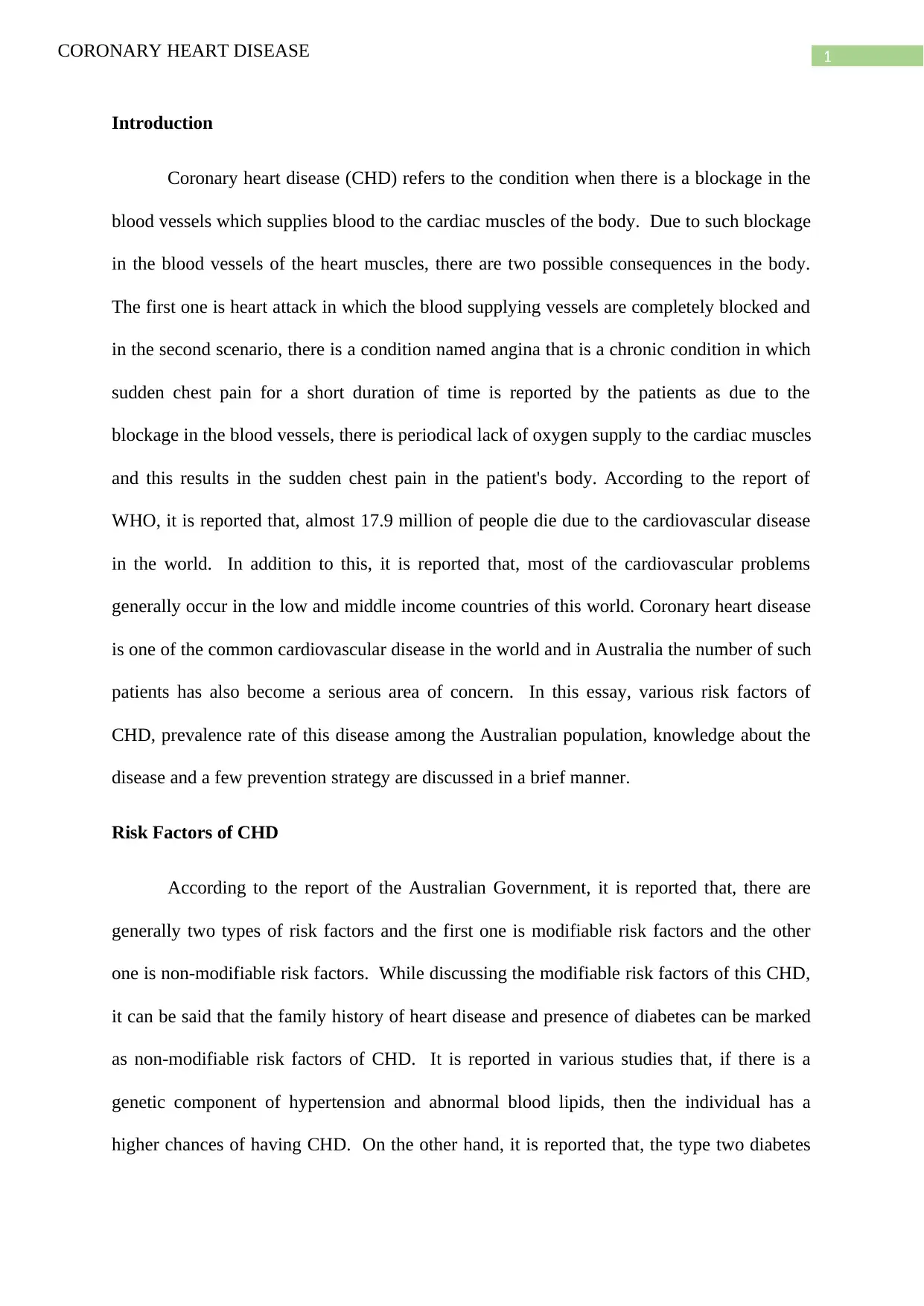
1CORONARY HEART DISEASE
Introduction
Coronary heart disease (CHD) refers to the condition when there is a blockage in the
blood vessels which supplies blood to the cardiac muscles of the body. Due to such blockage
in the blood vessels of the heart muscles, there are two possible consequences in the body.
The first one is heart attack in which the blood supplying vessels are completely blocked and
in the second scenario, there is a condition named angina that is a chronic condition in which
sudden chest pain for a short duration of time is reported by the patients as due to the
blockage in the blood vessels, there is periodical lack of oxygen supply to the cardiac muscles
and this results in the sudden chest pain in the patient's body. According to the report of
WHO, it is reported that, almost 17.9 million of people die due to the cardiovascular disease
in the world. In addition to this, it is reported that, most of the cardiovascular problems
generally occur in the low and middle income countries of this world. Coronary heart disease
is one of the common cardiovascular disease in the world and in Australia the number of such
patients has also become a serious area of concern. In this essay, various risk factors of
CHD, prevalence rate of this disease among the Australian population, knowledge about the
disease and a few prevention strategy are discussed in a brief manner.
Risk Factors of CHD
According to the report of the Australian Government, it is reported that, there are
generally two types of risk factors and the first one is modifiable risk factors and the other
one is non-modifiable risk factors. While discussing the modifiable risk factors of this CHD,
it can be said that the family history of heart disease and presence of diabetes can be marked
as non-modifiable risk factors of CHD. It is reported in various studies that, if there is a
genetic component of hypertension and abnormal blood lipids, then the individual has a
higher chances of having CHD. On the other hand, it is reported that, the type two diabetes
Introduction
Coronary heart disease (CHD) refers to the condition when there is a blockage in the
blood vessels which supplies blood to the cardiac muscles of the body. Due to such blockage
in the blood vessels of the heart muscles, there are two possible consequences in the body.
The first one is heart attack in which the blood supplying vessels are completely blocked and
in the second scenario, there is a condition named angina that is a chronic condition in which
sudden chest pain for a short duration of time is reported by the patients as due to the
blockage in the blood vessels, there is periodical lack of oxygen supply to the cardiac muscles
and this results in the sudden chest pain in the patient's body. According to the report of
WHO, it is reported that, almost 17.9 million of people die due to the cardiovascular disease
in the world. In addition to this, it is reported that, most of the cardiovascular problems
generally occur in the low and middle income countries of this world. Coronary heart disease
is one of the common cardiovascular disease in the world and in Australia the number of such
patients has also become a serious area of concern. In this essay, various risk factors of
CHD, prevalence rate of this disease among the Australian population, knowledge about the
disease and a few prevention strategy are discussed in a brief manner.
Risk Factors of CHD
According to the report of the Australian Government, it is reported that, there are
generally two types of risk factors and the first one is modifiable risk factors and the other
one is non-modifiable risk factors. While discussing the modifiable risk factors of this CHD,
it can be said that the family history of heart disease and presence of diabetes can be marked
as non-modifiable risk factors of CHD. It is reported in various studies that, if there is a
genetic component of hypertension and abnormal blood lipids, then the individual has a
higher chances of having CHD. On the other hand, it is reported that, the type two diabetes
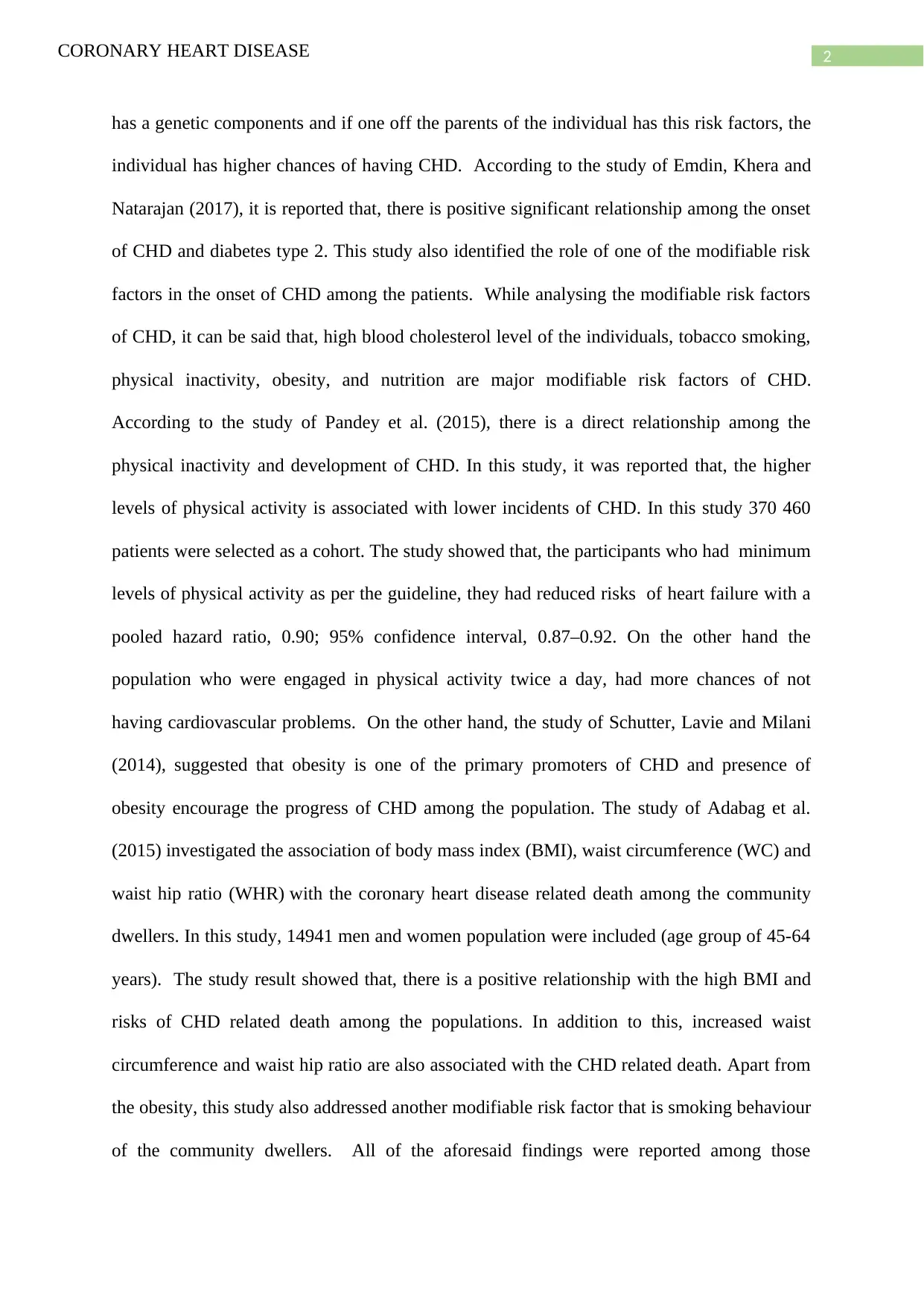
2CORONARY HEART DISEASE
has a genetic components and if one off the parents of the individual has this risk factors, the
individual has higher chances of having CHD. According to the study of Emdin, Khera and
Natarajan (2017), it is reported that, there is positive significant relationship among the onset
of CHD and diabetes type 2. This study also identified the role of one of the modifiable risk
factors in the onset of CHD among the patients. While analysing the modifiable risk factors
of CHD, it can be said that, high blood cholesterol level of the individuals, tobacco smoking,
physical inactivity, obesity, and nutrition are major modifiable risk factors of CHD.
According to the study of Pandey et al. (2015), there is a direct relationship among the
physical inactivity and development of CHD. In this study, it was reported that, the higher
levels of physical activity is associated with lower incidents of CHD. In this study 370 460
patients were selected as a cohort. The study showed that, the participants who had minimum
levels of physical activity as per the guideline, they had reduced risks of heart failure with a
pooled hazard ratio, 0.90; 95% confidence interval, 0.87–0.92. On the other hand the
population who were engaged in physical activity twice a day, had more chances of not
having cardiovascular problems. On the other hand, the study of Schutter, Lavie and Milani
(2014), suggested that obesity is one of the primary promoters of CHD and presence of
obesity encourage the progress of CHD among the population. The study of Adabag et al.
(2015) investigated the association of body mass index (BMI), waist circumference (WC) and
waist hip ratio (WHR) with the coronary heart disease related death among the community
dwellers. In this study, 14941 men and women population were included (age group of 45-64
years). The study result showed that, there is a positive relationship with the high BMI and
risks of CHD related death among the populations. In addition to this, increased waist
circumference and waist hip ratio are also associated with the CHD related death. Apart from
the obesity, this study also addressed another modifiable risk factor that is smoking behaviour
of the community dwellers. All of the aforesaid findings were reported among those
has a genetic components and if one off the parents of the individual has this risk factors, the
individual has higher chances of having CHD. According to the study of Emdin, Khera and
Natarajan (2017), it is reported that, there is positive significant relationship among the onset
of CHD and diabetes type 2. This study also identified the role of one of the modifiable risk
factors in the onset of CHD among the patients. While analysing the modifiable risk factors
of CHD, it can be said that, high blood cholesterol level of the individuals, tobacco smoking,
physical inactivity, obesity, and nutrition are major modifiable risk factors of CHD.
According to the study of Pandey et al. (2015), there is a direct relationship among the
physical inactivity and development of CHD. In this study, it was reported that, the higher
levels of physical activity is associated with lower incidents of CHD. In this study 370 460
patients were selected as a cohort. The study showed that, the participants who had minimum
levels of physical activity as per the guideline, they had reduced risks of heart failure with a
pooled hazard ratio, 0.90; 95% confidence interval, 0.87–0.92. On the other hand the
population who were engaged in physical activity twice a day, had more chances of not
having cardiovascular problems. On the other hand, the study of Schutter, Lavie and Milani
(2014), suggested that obesity is one of the primary promoters of CHD and presence of
obesity encourage the progress of CHD among the population. The study of Adabag et al.
(2015) investigated the association of body mass index (BMI), waist circumference (WC) and
waist hip ratio (WHR) with the coronary heart disease related death among the community
dwellers. In this study, 14941 men and women population were included (age group of 45-64
years). The study result showed that, there is a positive relationship with the high BMI and
risks of CHD related death among the populations. In addition to this, increased waist
circumference and waist hip ratio are also associated with the CHD related death. Apart from
the obesity, this study also addressed another modifiable risk factor that is smoking behaviour
of the community dwellers. All of the aforesaid findings were reported among those
⊘ This is a preview!⊘
Do you want full access?
Subscribe today to unlock all pages.

Trusted by 1+ million students worldwide
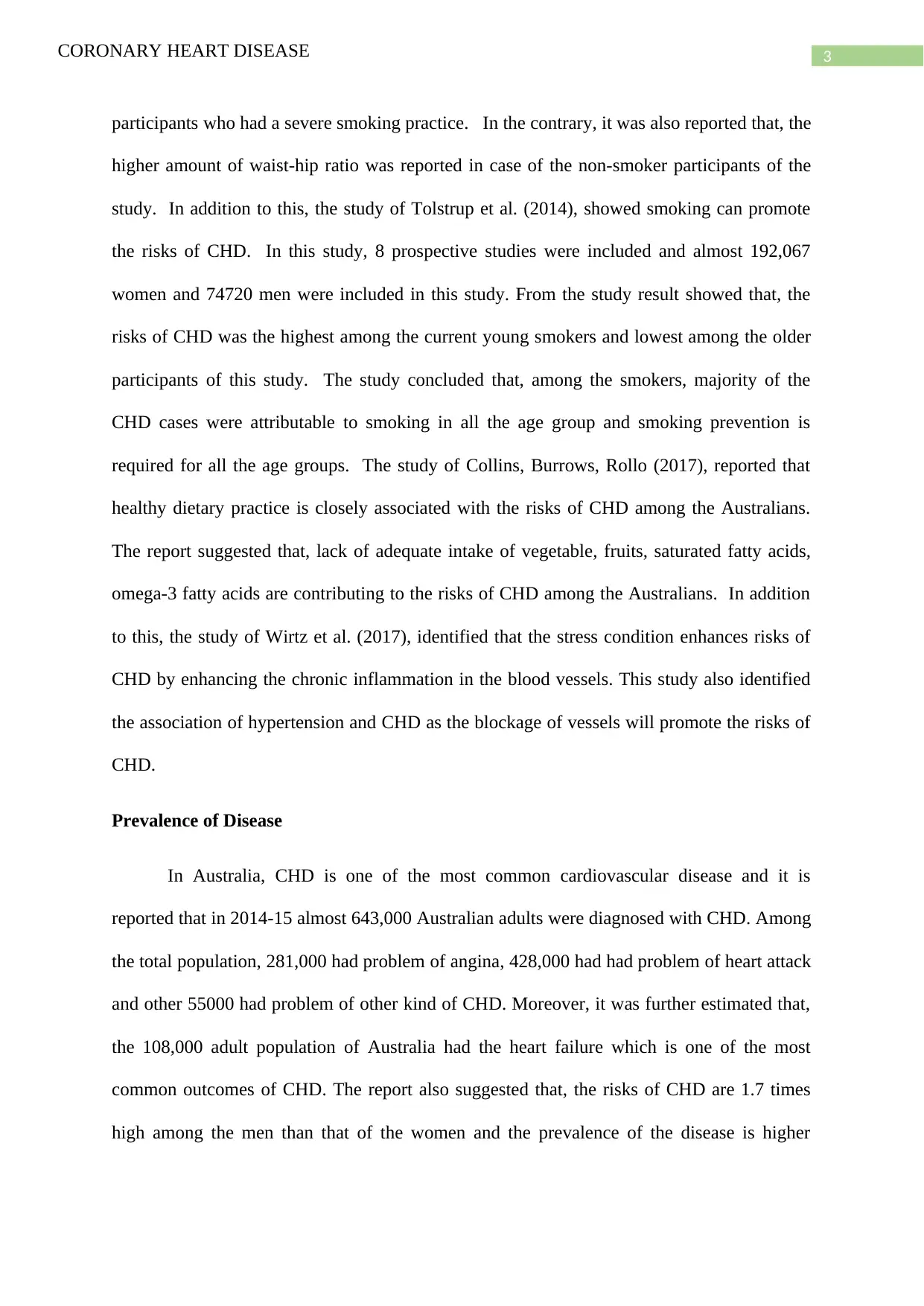
3CORONARY HEART DISEASE
participants who had a severe smoking practice. In the contrary, it was also reported that, the
higher amount of waist-hip ratio was reported in case of the non-smoker participants of the
study. In addition to this, the study of Tolstrup et al. (2014), showed smoking can promote
the risks of CHD. In this study, 8 prospective studies were included and almost 192,067
women and 74720 men were included in this study. From the study result showed that, the
risks of CHD was the highest among the current young smokers and lowest among the older
participants of this study. The study concluded that, among the smokers, majority of the
CHD cases were attributable to smoking in all the age group and smoking prevention is
required for all the age groups. The study of Collins, Burrows, Rollo (2017), reported that
healthy dietary practice is closely associated with the risks of CHD among the Australians.
The report suggested that, lack of adequate intake of vegetable, fruits, saturated fatty acids,
omega-3 fatty acids are contributing to the risks of CHD among the Australians. In addition
to this, the study of Wirtz et al. (2017), identified that the stress condition enhances risks of
CHD by enhancing the chronic inflammation in the blood vessels. This study also identified
the association of hypertension and CHD as the blockage of vessels will promote the risks of
CHD.
Prevalence of Disease
In Australia, CHD is one of the most common cardiovascular disease and it is
reported that in 2014-15 almost 643,000 Australian adults were diagnosed with CHD. Among
the total population, 281,000 had problem of angina, 428,000 had had problem of heart attack
and other 55000 had problem of other kind of CHD. Moreover, it was further estimated that,
the 108,000 adult population of Australia had the heart failure which is one of the most
common outcomes of CHD. The report also suggested that, the risks of CHD are 1.7 times
high among the men than that of the women and the prevalence of the disease is higher
participants who had a severe smoking practice. In the contrary, it was also reported that, the
higher amount of waist-hip ratio was reported in case of the non-smoker participants of the
study. In addition to this, the study of Tolstrup et al. (2014), showed smoking can promote
the risks of CHD. In this study, 8 prospective studies were included and almost 192,067
women and 74720 men were included in this study. From the study result showed that, the
risks of CHD was the highest among the current young smokers and lowest among the older
participants of this study. The study concluded that, among the smokers, majority of the
CHD cases were attributable to smoking in all the age group and smoking prevention is
required for all the age groups. The study of Collins, Burrows, Rollo (2017), reported that
healthy dietary practice is closely associated with the risks of CHD among the Australians.
The report suggested that, lack of adequate intake of vegetable, fruits, saturated fatty acids,
omega-3 fatty acids are contributing to the risks of CHD among the Australians. In addition
to this, the study of Wirtz et al. (2017), identified that the stress condition enhances risks of
CHD by enhancing the chronic inflammation in the blood vessels. This study also identified
the association of hypertension and CHD as the blockage of vessels will promote the risks of
CHD.
Prevalence of Disease
In Australia, CHD is one of the most common cardiovascular disease and it is
reported that in 2014-15 almost 643,000 Australian adults were diagnosed with CHD. Among
the total population, 281,000 had problem of angina, 428,000 had had problem of heart attack
and other 55000 had problem of other kind of CHD. Moreover, it was further estimated that,
the 108,000 adult population of Australia had the heart failure which is one of the most
common outcomes of CHD. The report also suggested that, the risks of CHD are 1.7 times
high among the men than that of the women and the prevalence of the disease is higher
Paraphrase This Document
Need a fresh take? Get an instant paraphrase of this document with our AI Paraphraser

4CORONARY HEART DISEASE
among the older population of the country. It was estimated that, almost 65300 adult people
in the age group of 25 years or more, had experienced heart attack or angina.
Knowledge about CHD
According to the study of Hoare et al. (2017), there is a broad misconception about
the cause of death and risk factors of CHD among the Australian adults. In this study,
Australian adults within the age group of 35-59 were included. The study showed that, only a
low proportion of subject population were able to recognize the clinical risk factors of CHD
such as high blood pressure (6.3%, 95%CI 5.8–6.8) and dyslipidaemia (9.8%, 95%CI 9.2–
10.5). On the other hand, most of the participants were aware about the risk factors of the
disease such as poor diet (58.2%, 95%CI 57.0–59.1), physical inactivity (49.0%, 95%CI
47.9–50.1) and smoking (38.7%, 95%CI 37.7–39.8). The overall study findings showed that,
there is overall need of knowledge among the adult population of Australia. Moreover, it is
very important to have adequate knowledge about this disease and its related risk factors as it
can help in prevention of the disease among the Australians. The study of Amadi et al.
(2018), knowledge regarding CHD has become successful in preventing the cardiovascular
problems among the community people of Nigeria. So, it can be said that, this may help in
improving the condition of Australian adults.
Prevention Strategy
An individual’s behaviour and practice plays vital role in the prevention of the
coronary heart disease. It has been reported in the research studies that the both physical
aspects like lifestyle choices and psychological aspect influence the onset of coronary heart
disease (Astin, Horrocks& Closs, 2014). Studies have shown that physical exercise has been
able to prevent CHD in an individual (Astin, Horrocks& Closs, 2014). Furthermore, lifestyle
choices like smoking and dietary habits have also shown to lower the risk of CHD. In
among the older population of the country. It was estimated that, almost 65300 adult people
in the age group of 25 years or more, had experienced heart attack or angina.
Knowledge about CHD
According to the study of Hoare et al. (2017), there is a broad misconception about
the cause of death and risk factors of CHD among the Australian adults. In this study,
Australian adults within the age group of 35-59 were included. The study showed that, only a
low proportion of subject population were able to recognize the clinical risk factors of CHD
such as high blood pressure (6.3%, 95%CI 5.8–6.8) and dyslipidaemia (9.8%, 95%CI 9.2–
10.5). On the other hand, most of the participants were aware about the risk factors of the
disease such as poor diet (58.2%, 95%CI 57.0–59.1), physical inactivity (49.0%, 95%CI
47.9–50.1) and smoking (38.7%, 95%CI 37.7–39.8). The overall study findings showed that,
there is overall need of knowledge among the adult population of Australia. Moreover, it is
very important to have adequate knowledge about this disease and its related risk factors as it
can help in prevention of the disease among the Australians. The study of Amadi et al.
(2018), knowledge regarding CHD has become successful in preventing the cardiovascular
problems among the community people of Nigeria. So, it can be said that, this may help in
improving the condition of Australian adults.
Prevention Strategy
An individual’s behaviour and practice plays vital role in the prevention of the
coronary heart disease. It has been reported in the research studies that the both physical
aspects like lifestyle choices and psychological aspect influence the onset of coronary heart
disease (Astin, Horrocks& Closs, 2014). Studies have shown that physical exercise has been
able to prevent CHD in an individual (Astin, Horrocks& Closs, 2014). Furthermore, lifestyle
choices like smoking and dietary habits have also shown to lower the risk of CHD. In

5CORONARY HEART DISEASE
addition to that blood pressure level, body weight and alcohol consumption also plays a
major role in reducing the chance of CHD (Astin, Horrocks& Closs, 2014).
Psychological aspect of an individual can also influence the onset of the CHD among
the people. Studies have shown that the psychological aspects like depression, stress plays a
crucial role on the onset of the CHD (Cohen, Edmondson & Kronish, 2015).
Hence, controlling the above mentioned aspect by an individual can help prevent the
onset of CHD.
Conclusion
Therefore, from the above discussion, it can be stated that the CHD is a major burden
on the global health care system and Australia is no different to this situation. There are
mainly two types of the risk factors for the CHD known as modifiable and non- modifiable
risk factors. Hence, an individual can reduce the risk of onset of CHD by modifying their risk
factors.
addition to that blood pressure level, body weight and alcohol consumption also plays a
major role in reducing the chance of CHD (Astin, Horrocks& Closs, 2014).
Psychological aspect of an individual can also influence the onset of the CHD among
the people. Studies have shown that the psychological aspects like depression, stress plays a
crucial role on the onset of the CHD (Cohen, Edmondson & Kronish, 2015).
Hence, controlling the above mentioned aspect by an individual can help prevent the
onset of CHD.
Conclusion
Therefore, from the above discussion, it can be stated that the CHD is a major burden
on the global health care system and Australia is no different to this situation. There are
mainly two types of the risk factors for the CHD known as modifiable and non- modifiable
risk factors. Hence, an individual can reduce the risk of onset of CHD by modifying their risk
factors.
⊘ This is a preview!⊘
Do you want full access?
Subscribe today to unlock all pages.

Trusted by 1+ million students worldwide
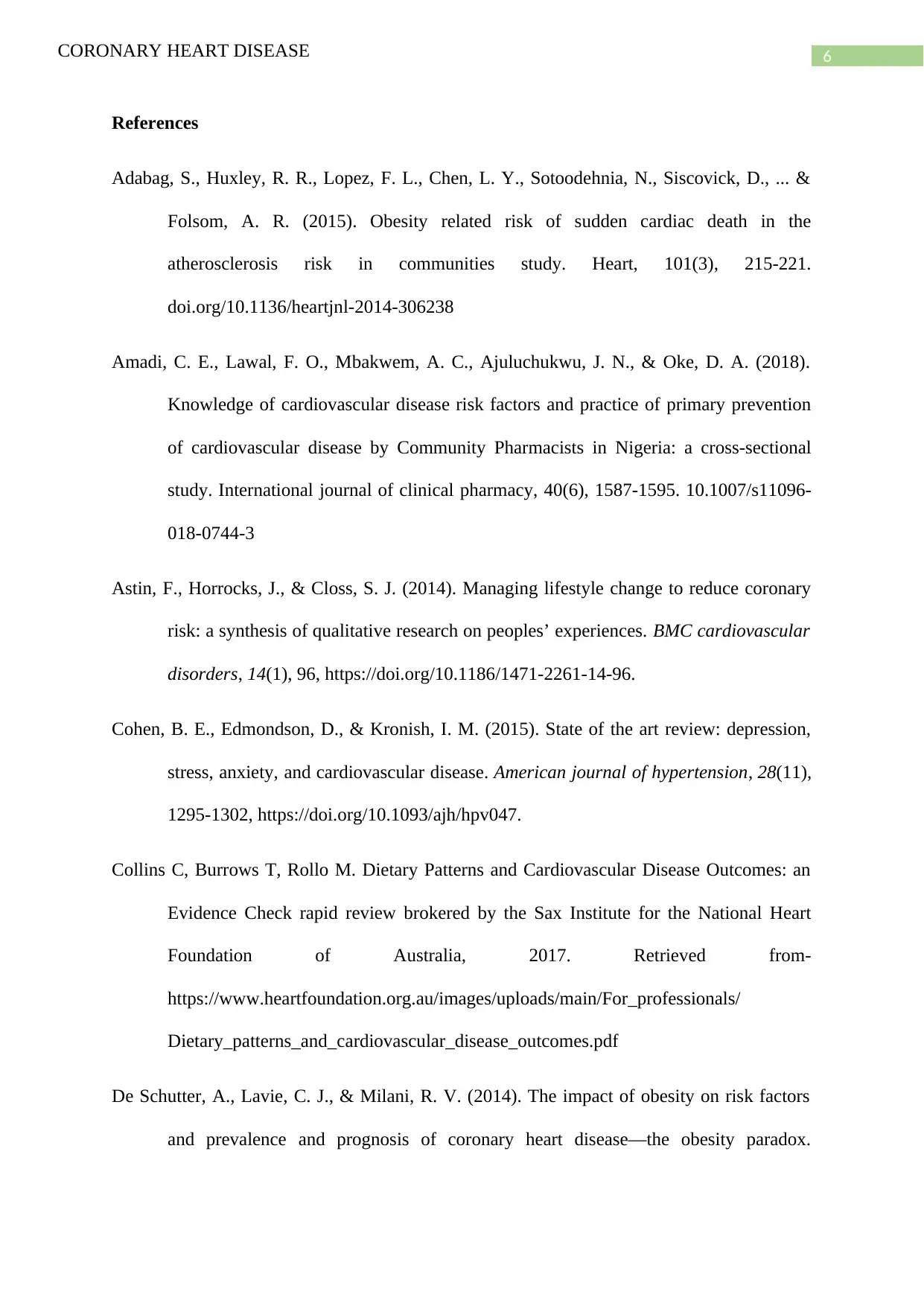
6CORONARY HEART DISEASE
References
Adabag, S., Huxley, R. R., Lopez, F. L., Chen, L. Y., Sotoodehnia, N., Siscovick, D., ... &
Folsom, A. R. (2015). Obesity related risk of sudden cardiac death in the
atherosclerosis risk in communities study. Heart, 101(3), 215-221.
doi.org/10.1136/heartjnl-2014-306238
Amadi, C. E., Lawal, F. O., Mbakwem, A. C., Ajuluchukwu, J. N., & Oke, D. A. (2018).
Knowledge of cardiovascular disease risk factors and practice of primary prevention
of cardiovascular disease by Community Pharmacists in Nigeria: a cross-sectional
study. International journal of clinical pharmacy, 40(6), 1587-1595. 10.1007/s11096-
018-0744-3
Astin, F., Horrocks, J., & Closs, S. J. (2014). Managing lifestyle change to reduce coronary
risk: a synthesis of qualitative research on peoples’ experiences. BMC cardiovascular
disorders, 14(1), 96, https://doi.org/10.1186/1471-2261-14-96.
Cohen, B. E., Edmondson, D., & Kronish, I. M. (2015). State of the art review: depression,
stress, anxiety, and cardiovascular disease. American journal of hypertension, 28(11),
1295-1302, https://doi.org/10.1093/ajh/hpv047.
Collins C, Burrows T, Rollo M. Dietary Patterns and Cardiovascular Disease Outcomes: an
Evidence Check rapid review brokered by the Sax Institute for the National Heart
Foundation of Australia, 2017. Retrieved from-
https://www.heartfoundation.org.au/images/uploads/main/For_professionals/
Dietary_patterns_and_cardiovascular_disease_outcomes.pdf
De Schutter, A., Lavie, C. J., & Milani, R. V. (2014). The impact of obesity on risk factors
and prevalence and prognosis of coronary heart disease—the obesity paradox.
References
Adabag, S., Huxley, R. R., Lopez, F. L., Chen, L. Y., Sotoodehnia, N., Siscovick, D., ... &
Folsom, A. R. (2015). Obesity related risk of sudden cardiac death in the
atherosclerosis risk in communities study. Heart, 101(3), 215-221.
doi.org/10.1136/heartjnl-2014-306238
Amadi, C. E., Lawal, F. O., Mbakwem, A. C., Ajuluchukwu, J. N., & Oke, D. A. (2018).
Knowledge of cardiovascular disease risk factors and practice of primary prevention
of cardiovascular disease by Community Pharmacists in Nigeria: a cross-sectional
study. International journal of clinical pharmacy, 40(6), 1587-1595. 10.1007/s11096-
018-0744-3
Astin, F., Horrocks, J., & Closs, S. J. (2014). Managing lifestyle change to reduce coronary
risk: a synthesis of qualitative research on peoples’ experiences. BMC cardiovascular
disorders, 14(1), 96, https://doi.org/10.1186/1471-2261-14-96.
Cohen, B. E., Edmondson, D., & Kronish, I. M. (2015). State of the art review: depression,
stress, anxiety, and cardiovascular disease. American journal of hypertension, 28(11),
1295-1302, https://doi.org/10.1093/ajh/hpv047.
Collins C, Burrows T, Rollo M. Dietary Patterns and Cardiovascular Disease Outcomes: an
Evidence Check rapid review brokered by the Sax Institute for the National Heart
Foundation of Australia, 2017. Retrieved from-
https://www.heartfoundation.org.au/images/uploads/main/For_professionals/
Dietary_patterns_and_cardiovascular_disease_outcomes.pdf
De Schutter, A., Lavie, C. J., & Milani, R. V. (2014). The impact of obesity on risk factors
and prevalence and prognosis of coronary heart disease—the obesity paradox.
Paraphrase This Document
Need a fresh take? Get an instant paraphrase of this document with our AI Paraphraser
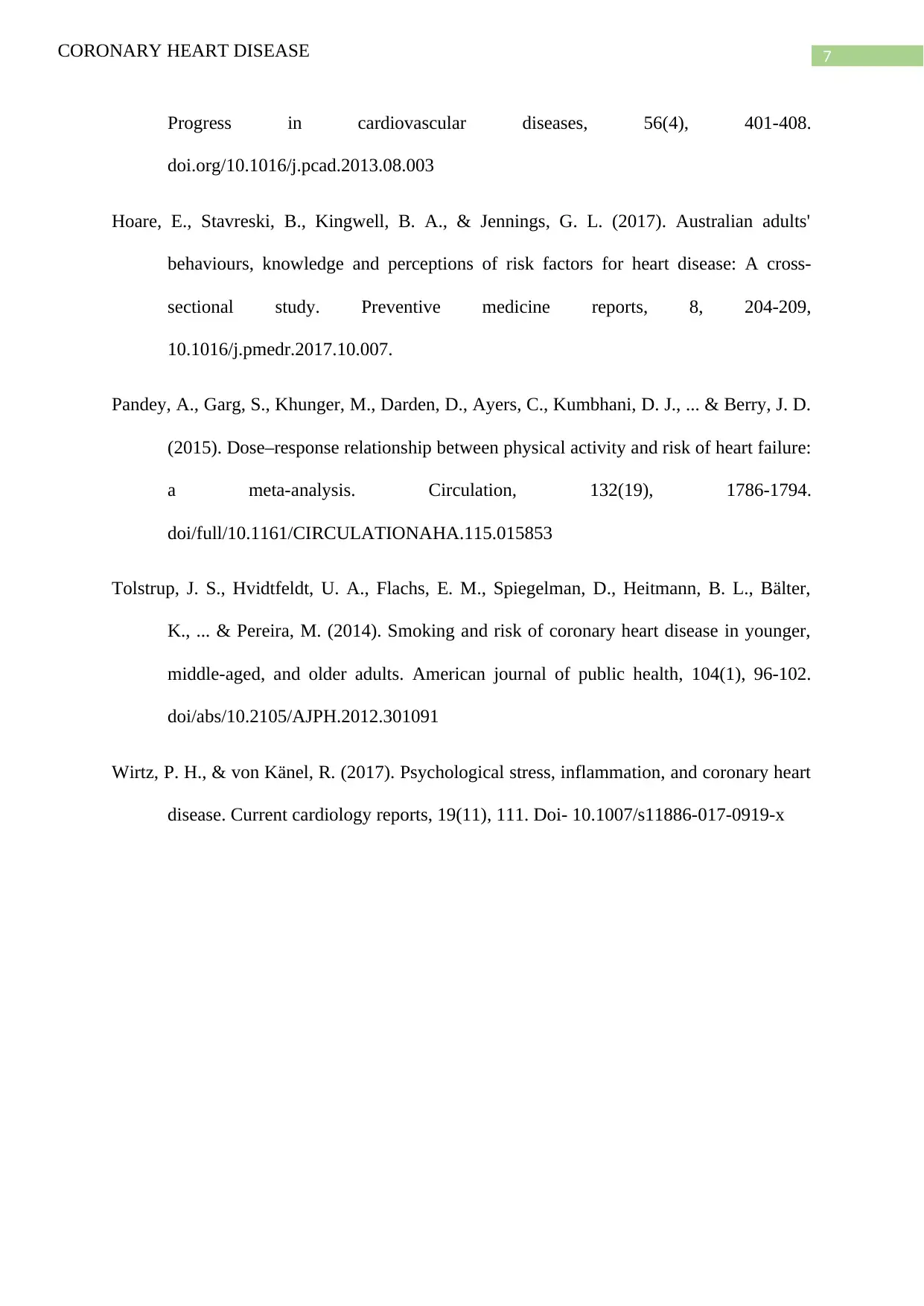
7CORONARY HEART DISEASE
Progress in cardiovascular diseases, 56(4), 401-408.
doi.org/10.1016/j.pcad.2013.08.003
Hoare, E., Stavreski, B., Kingwell, B. A., & Jennings, G. L. (2017). Australian adults'
behaviours, knowledge and perceptions of risk factors for heart disease: A cross-
sectional study. Preventive medicine reports, 8, 204-209,
10.1016/j.pmedr.2017.10.007.
Pandey, A., Garg, S., Khunger, M., Darden, D., Ayers, C., Kumbhani, D. J., ... & Berry, J. D.
(2015). Dose–response relationship between physical activity and risk of heart failure:
a meta-analysis. Circulation, 132(19), 1786-1794.
doi/full/10.1161/CIRCULATIONAHA.115.015853
Tolstrup, J. S., Hvidtfeldt, U. A., Flachs, E. M., Spiegelman, D., Heitmann, B. L., Bälter,
K., ... & Pereira, M. (2014). Smoking and risk of coronary heart disease in younger,
middle-aged, and older adults. American journal of public health, 104(1), 96-102.
doi/abs/10.2105/AJPH.2012.301091
Wirtz, P. H., & von Känel, R. (2017). Psychological stress, inflammation, and coronary heart
disease. Current cardiology reports, 19(11), 111. Doi- 10.1007/s11886-017-0919-x
Progress in cardiovascular diseases, 56(4), 401-408.
doi.org/10.1016/j.pcad.2013.08.003
Hoare, E., Stavreski, B., Kingwell, B. A., & Jennings, G. L. (2017). Australian adults'
behaviours, knowledge and perceptions of risk factors for heart disease: A cross-
sectional study. Preventive medicine reports, 8, 204-209,
10.1016/j.pmedr.2017.10.007.
Pandey, A., Garg, S., Khunger, M., Darden, D., Ayers, C., Kumbhani, D. J., ... & Berry, J. D.
(2015). Dose–response relationship between physical activity and risk of heart failure:
a meta-analysis. Circulation, 132(19), 1786-1794.
doi/full/10.1161/CIRCULATIONAHA.115.015853
Tolstrup, J. S., Hvidtfeldt, U. A., Flachs, E. M., Spiegelman, D., Heitmann, B. L., Bälter,
K., ... & Pereira, M. (2014). Smoking and risk of coronary heart disease in younger,
middle-aged, and older adults. American journal of public health, 104(1), 96-102.
doi/abs/10.2105/AJPH.2012.301091
Wirtz, P. H., & von Känel, R. (2017). Psychological stress, inflammation, and coronary heart
disease. Current cardiology reports, 19(11), 111. Doi- 10.1007/s11886-017-0919-x
1 out of 8
Related Documents
Your All-in-One AI-Powered Toolkit for Academic Success.
+13062052269
info@desklib.com
Available 24*7 on WhatsApp / Email
![[object Object]](/_next/static/media/star-bottom.7253800d.svg)
Unlock your academic potential
Copyright © 2020–2026 A2Z Services. All Rights Reserved. Developed and managed by ZUCOL.





